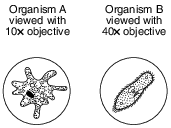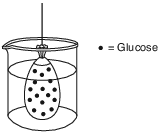Topic: Lab Diffusion Through A Membrane
Lab Diffusion Through A Membrane
A coverslip should be slowly lowered from a 45° angle onto a slide in order to
(1) prevent the slide from being scratched
(2) stop the loss of water from under the coverslip
(3) ensure that the specimen being viewed will stay alive
(4) reduce the formation of air bubbles
A substance is most likely to diffuse into a cell when
(1) it is a large organic food molecule such as protein or starch
(2) it is enclosed in an organelle such as a vacuole
(3) the concentration of the substance is greater outside the cell than inside
(4) the pH of the substance is greater than the pH of the cell
The drawings below were made during a laboratory exercise in which a microscope was used to view slides of preserved protozoa. The microscope had a 10× eyepiece and two different objectives.

Which statement about the size of the organisms is correct?
(1) Organism A is larger than organism B.
(2) Organism B is larger than organism A.
(3) Organisms A and B are both the same size.
(4) The relative size of the organisms cannot be determined from the information given.

Which statement best describes what will most likely happen after several minutes?
(1) The contents of the model cell will change color.
(2) The liquid outside the model cell will change color.
(3) The model cell will shrink.
(4) The model cell will rupture.
The diagram below represents a compound light microscope. Several parts have been labeled.

In order to make an image brighter, which labeled part of the microscope would most likely be adjusted?
(1) A
(2) B
(3) C
(4) D
Cell membranes are said to be selectively permeable. Which statement best explains what selectively permeable means?
(1) The cell membrane prevents any harmful substance from entering the cell.
(2) The cell membrane lets certain substances enter the cell and keeps certain substances out of the cell.
(3) The cell membrane allows only large molecules to diffuse into the cell.
(4) The cell membrane has pores that let only water and glucose into the cell and carbon dioxide out.
One of the effects of Hurricane Katrina, which devastated New Orleans in 2005, was the death of almost all of the plants in flooded areas. Initially, toxic chemicals and bacteria were suspected as a possible cause. Scientists later determined that the salt concentration in the floodwater caused the plants to die.
The death of the plants was most likely due to
(1) water moving into plant cells from the surrounding environment
(2) water moving out of plant cells into the surrounding environment
(3) both water and salt moving from plant cells into the surrounding environment
(4) both water and salt moving into plant cells from the surrounding environment
The diagram below represents a laboratory setup used to demonstrate the movement of molecules across a selectively permeable membrane.

In the diagram below, draw the 5 starch and the 12 glucose molecules to show where they would most likely be located after 15 minutes. [1]

Allow 1 credit for a response showing the five starch molecules only on the left side and glucose
• molecules distributed on both sides.
• Example of a 1-credit response:
• 
• Note: The number of glucose molecules on each side does not have to be equal.
The diagram below represents a laboratory technique.

State one reason a student would use this technique during a scientific investigation. [1]
Allow 1 credit. Acceptable responses include, but are not limited to:
• — to add a solution to a slide without removing the coverslip
• — to add stain (or water) to a slide
An athlete bought a sport gel food and wanted to test it to see if it contained fats, starches, and glucose. The tests that the student used are shown in the table below.

The athlete received the following results from the tests.

Identify the contents of the sports gel. [1]
Allow 1 credit for starch and glucose.
There is a group of plants, known as halophytes, that has traits that enable them to survive in salty environments. Describe one change, other than death, that would be observed in the cells of a plant that did not have these traits and was planted in a salty environment. [1]
Allow 1 credit. Acceptable responses include, but are not limited to:
• — The cells of the plant would lose water and shrink.
• — Water would leave the cells of the plant, and they would shrink.
• — The contents of the plant’s cells would shrink.
• — The plant’s cells would lose most of their water/become dehydrated.
• — plasmolysis
The diagram below represents a lab setup. The artificial cell (dialysis tube) contains a starch solution and the beaker contains a solution of starch indicator and water. The setup is left undisturbed for twenty minutes.

Identify one molecule, present in this setup, that will be able to pass through the dialysis tubing. [1]
Allow 1 credit for starch indicator/iodine or water.
An artificial cell filled with a glucose solution was placed in a beaker of water, as represented below. The beaker was left undisturbed for 20 minutes.

In the diagram below, draw in the expected location of the glucose molecules after 20 minutes. [1]

Allow 1 credit for drawing the expected location of the glucose molecules after 20 minutes.
• Example of a 1-credit response:
• 
• Note: The actual number of glucose molecules is not important, as long as some glucose is located
• both inside and outside the cell.
State one advantage of using a stain to study frog skin cells with a microscope. [1]
Allow 1 credit. Acceptable responses include, but are not limited to:
• — A stain makes some organelles more visible.
• — easier to see cell parts

Describe procedure A and explain why it would cause the change shown. [1]
Allow 1 credit for stating both a description of the procedure and an explanation. Acceptable
• responses include, but are not limited to:
• — In procedure A, salt water is added to the cell. The reduced water concentration outside
• results in water leaving the cell and its cytoplasm shrinks away from the cell wall.
• — Put the cell in salt solution. Water moves out of the cell and the cell contents shrink.
